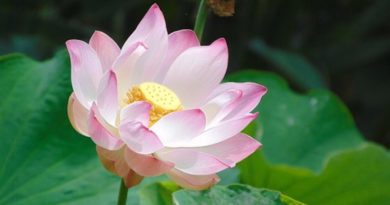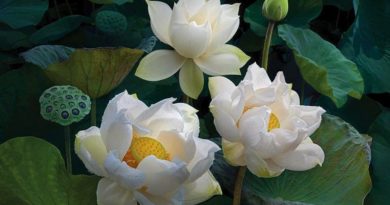THE CONCEPT OF PERSONALITY REVEALED THROUGH THE PANCANIKAYA – PART I: GENERAL INTRODUCTION, CHAPTER 1: INTRODUCTION
MAIN CONTENT
THE CONCEPT OF PERSONALITY REVEALED THROUGH THE PANCANIKAYA – PART I: GENERAL INTRODUCTION
CHAPTER 1: INTRODUCTION
I.1.1: TITLE AND CLARIFICATION OF THE TOPIC
Education is often understood as what has made up culture and civilization of a country. It includes creative works as the source of civilization, and its various roles of building and developing society as the source of the culture of a people. Education, culture and civilization all are products of man’s way of thinking. People of all times always wish safety, peace and happiness to themselves. A system of human education or culture must therefore bring safety, peace and happiness to human beings. Such a system of education, or such a course of culture, must be based on an ideal system of educational philosophy, psychology, and an ideal pattern of education. These important educational problems, in the author’s opinion, must come from an ideal theory of personality which can tell the truth of man, life and the unseparable relationship between them.
As people could know, the civilization of human beings of nowadays is in crises. The developed countries have centered on developing light and heavy industries, especially the heavy ones. The developing countries are on their ways to industrialization. They are all concerned much about the development of economy -ie. concerned much about production and advantages – and in the process almost ignoring the development of a moral and spiritual way of life. This course of development relating to the craving (tanha) and grasping (upadana) of human beings has brought to this world cold and hot wars, the serious pollution of the environment and ethical, social crises. The contemporary educators, religious leaders, ecologists etc., all over the world have warned us of the danger of mass-destruction through atomic and chemical wars, and air, land and water pollution.
There are also other values of the current education that need to be re-evaluated and clarified through the Lord Buddha’s teachings, such as:
1.The problem of competition:
The civilization of the twentieth century is based on the spirit of competition. For Westerners, this spirit can help them have a fast development of economy and culture. But, in reality, it has caused the crises as mentioned above. So it must be reviewed.
Competition itself is an effort of a man who wants to be stronger or better than others, while his main problem is as to how to be better than what he is now, as Lord Buddha taught:
-.” If one man conquer in battle a thousand times thousand men, and if another conquer himself, the latter is the greatest of conquerors”. (1) (Dhp. 103)
-(” Yo sahassam sahassena sangame manusse jine Ekanca jeyyamattanam sa ve sangamajuttamo”).(2) (Dhp. 103 )
-” One’s own self – conquered is better than all other people; not even a god, a gandharva, not Mara with Brahman could change into defeat the victory of a man who has vanquished himself, and always lives under restraint” (3) + (4). (Dhp. 104 – 105)
( “Atta have jitam seyyo ya cayam itara paja Attadantassa posassa niccam sanatacarino” (5)
” Neva devo, na gandhabbo, na maro sahabrahmmuna Jitam apajitam kayira tatharuapassa jantuno”.) (6)
2.The problem of training only a social man:
The economic and industrial development requires a system of education emphasizing the training of a social man, or a man of power, while an education of humanness requires a man himself.
For a man himself, he should know who he really is, and how to attain happiness in the here-and-now. With regard to this, Lord Buddha said:
-” Self is the lord of self, who else could be the lord ? With the self well subdued, a man finds a lord such as few can find”. (7) (Dhp. 160)
(” Atta hi attano natho ko hi natho paro siya Attanaa’va sudantena natham labhati dullabham”) (8)
– ” Let the wise man guard his thoughts, for they are difficult to perceive, very artful, and they rush wherever they list: thoughts well guarded bring happiness”. (9) (Dhp.36)
-(” Sududdasam sunipunam yatthakamanipatin-am cittam Rakkheyya medhavi cittam guttam sukhavaham”) (10)
-” We live happily indeed, though we call nothing our own ! We shall be like the bright gods feeding on happiness”. (11) (Dhp. 200)
(” Susukham vata javama yesam no natthi kincanam Patibhakkha bhavissama deva abhassara yatha”) ( 12)
3.The problem of a pattern of education:
The contemporary educators tend to create a pattern of education. This means giving a fixed nature to a man, and stopping his process of becoming. It sounds like making shoes of one size for all people of different sizes. So, there must be something wrong in that pattern. For the truth of man, Lord Buddha declared:
– ” All forms are selfless”…
– (“Sabbe dhamma anatta”… )
4.The problem of interrelationship among things:
If a man cannot realize the interrelationship among things, he cannot realize the truth of man and life. His ignorance will cause him and his life lots of troubles, as it does in the case of environmental pollution. In this case, education should help men understand the truth of every existing thing to protect environment as well as men. The Buddhist doctrine of Dependent Origination (Paticcasamuppada)and the Five aggregates (Pancakkhandha) may be theories of this education for environment that will be discussed in the following pages.
5.Education for lasting peace for the world:
Peace is the absence of war. In schools, the science of history only mentions the events and apparent causes of peace and war, but not the motives coming from men’s mind. So, it cannot help human beings build up the lasting peace for the world.
According to Lord Buddha’s teachings, the root causes of all evil deeds, including wars, are greed (lobha), ill-will or hatred (dosa), and ignorance (moha). So, the best thing to be done to extinguish all wars is dealing with greed, ill-will, and ignorance by practising Dhamma as He taught:
-” Victory breeds hatred, for the conquered is unhappy. He who has given up both victory and defeat, he, the contended, is happy”(13) (Dhp. 201)
(” Jayam veram pasavati dukkham seti parajito Upasanto sukham seti hitva jayaparajayam”; (14)
-” We live happily indeed, not hating those who hate us ! Among men who hate us,we dwell free from hatred !” (15) (Dhp. 197)
(” Susukham vata jiavama verinesu averino Verinesu manussesu viharama averino”) (16)
-” We live happily indeed, free from greed among the greedy ! Among men who are greedy let us dwell free from greed !” (17) (Dhp. 199)
(” Susukham vata jiavama ussukesu anussuka Ussukesu manussesu viharama anussuka”) (18)
6.A system of educational philosophy:
Educational philosophy is used to serve educational purposes in opening a good course of education for men’s happiness. It is based on three spheres: epistemology, axiology and ontology. The current system of educational philosophy, as well as philosophy in common sense, is created by self-thought which is untrue, therefore it meets with crisis.
The truth of Dependent Origination (Paticcasamuppada) Lord Buddha realized will show the way to come out of the crisis which is the operation of non-self thought, or the operation of wisdom (panna or vijja) leading to the cessation of ignorance. This operation will be discussed in next chapter (I.2.)
7.Education to remove individual problems:
It may be said that all schools of thought from the old days are classified in three spheres:
- The third person sphere: All thoughts claiming that there exists the first cause of this universe are called thoughts of the third person – the person people are talking about. Since the role of mastering life of human beings has been lost in this sphere, this thought sphere is called alienation.
- The second person sphere: All thoughts claiming that truth exists in nature or the phenomena are called thoughts of the second person – the person people are talking to. This thought sphere is also called alienation because of the same reason as given above.
- The first person sphere: All thoughts claiming that a human being is the master of his own life, or life is for human beings’ happiness, are called thoughts of the first person – the person is talking. This thought sphere is humanist. It includes Buddhism, Existentialism, Phenomenology and world organizations for human rights that help a man awaken and turn back to himself. But here a man is still facing the hot problems caused by the contradiction between orders coming from his thinking and his desiring. This appears like the contradiction between the “Id” and the “Superego” discovered by Sigmund Freud. In the author’s mind this contradiction may only be resolved by the doctrine of Paticcasamuppada which suggests a way to come out of self-thought, desire and sufferings caused by them. This doctrine may also suggest many interesting thoughts on education that the author is going to mention next (in “I.2”.).
- On educational psychology:
Educational psychology is a branch of study examining theories of personality, human behaviours, the growth of children, adolescents and adults, also examining the nature of teaching, learning, the tools of research and evaluation, and the way of helping men resolve their problems for their happiness. With regard to the aim of understanding man, and of helping man be happy, many teachings of Lord Buddha recorded in Pancanikaya are available:
– “This is the case, monks, where an uninstructed average person, taking no account of the pure ones, unskilled in the dhamma of the pure ones, …, recognizes extension as extension, he thinks of extension, he thinks (of self as) extension, he thinks, “extension is mine” – he rejoices in extension. What is the reason for this ? I say that it is not thoroughly understood by him”.(19).
– (“Idha, bhikkhave, assutava puthujjano ariya-nam adassava ariya-dhammassa akovido ariyadhamme aviniato sappurisanam adass-avasappurisadhammassa akovido appurisad-hamme aviniato, pathavim pathavito sanjanati, pathavim pathavito sannatva pathavim mannati, pathaviya mannati, pathavito mannati, pathavim me ti mannati, pathavim abhinandati; tam kissa hetu: aparinnatam tassati vadami”). (20)
” And, monks, the Tathagata also, Perfected one, Fully self – awakened one, intuitively knows extension as extension; from intuitively knowing extension as extension, he does not think of extension, he does not think (of self) in (regard to) extension, he does not think (of self) as extension, he does not think, “extension is mine” – he does not rejoice in extension. What is the reason for this ? It is because he, having known that delight is the root of anguish, knows that from becoming there is birth, and that there is old age and dying for the being. Consequently I say, monks, that the Tathagata, by the waning of all cravings, by dispassion, by stopping, by abandoning, by completely renouncing, is wholly self – awakened to the incomparable Full self – awakening”.(21)
(“Tathagato pi, bhikkhave, araham sammasambuddho pathavim pathavito abhijanati, pathavim pathavito abhinnaya pathavim na mannati, pathaviya na mannati, pathavito na mannati, pathavim me ti na mannati, pathavim nabhinandati; tam kissa hetu: nanda dukkhassa mualanti iti viditva, bhava jati, bhuatassa jaramarananti. Tasmatiha, bhikkhave, Tathagato sabbaso tanhanam khaya viraga nirodha caga patinissagga anuttaram sammasambodhim abhisambuddho ti vadami”) (22)
And ” There are, monks, cankers that should be got rid of by vision, there are cankers that should be got rid of by endurance, there are cankers that should be got rid of by avoidance, … by elimination, … by development.” (23)
(” Atthi, bhikkhave, asava dassana pahatabba, atthi asava samvara pahatabba, atthi asava patisevana pahatabba,atthi asava adhivasana pahatabba, atthiasava parivajjana pahatabba, atthi asava vinodana pahatabba, atthi asava bhavana pahatabba”) (24)
9.A theory of personality:
The personality theory is the central point of education in general, of educational psychology in particular, on which the content of education, methods of teaching and counseling are based. The educational psychologists and theorists therefore always do their best to form it. The current personality theories by Freud, Carl Jung, Eric Fromn, Adler, Maslow, Lewin, Skinner, Allport, Carl Rogers, etc,. are useful and very well-known, but very limited; they cannot say the true nature of man and life, because they regard them as having a fixed nature while in fact they are impermanent and selfless.
In Buddhism, over fifteen centuries ago, and more than that, there were at least three personality theories formed, such as Abhidhamma of Theravada Buddhist Sect, Abhidharmakosa of Sarvastivada Sect, and Vijnanavada of Mahayanist Sect. All of them are mental analyses which divide a person’s mind into healthy or good mental factors. (kusala cittas), unhealthy mental factors (akusala cittas) and neither healthy nor unhealthy mental factors. All of them also relate to the practice of meditation as a means to realize one’s mind and to release sufferings.
In this work, the author only mentions the personality theory taught directly by Lord Gotama Buddha, and recorded in the Pancanikaya. Lord Buddha did introduce it in different forms: sixfold-sense-fields (salayatana); sixsense-organs and six sense-objects; six sense-organs, six sense-objects and six consciousnesses; five aggregates (pancakkhandha); and Dependent Origination (Paticcasamuppada). The writer believes only the doctrine of Dependent Origination and of the five aggregates can say what a person really is, and can show the way to come out of individuals’ problems and social crises. Let us now follow some of Lord Buddha’s teachings regarding to the root purpose of education of the modern time:
– ” How, brethren, the untaught many – folk have this view: “This body is mine: I am this: this is myself !” Of such an one the body alters and becomes otherwise. Owing to the altering and otherwiseness of body, sorrow and grief, woe, lamentation and despair arise in him.
– So also with regard to feeling, perception, activities and consciousness.
– And how, brethren, is there no grasping and no worry ?
– Herein, brethren, the well-taught Ariyan disciple has this view: “This body is not mine: I am not this: this is not my self”. Of such an one the body alters and becomes otherwiseness. But in spite of altering and otherwiseness of body, sorrow and grief, woe, lamentation and despair arise not in him. So also with regard to feeling, perception, activities and consciousness”. (25)
– (” Katham ca, bhikkhave upada – paritassanahoti. Idha, bhikkhave, assutava puthujjano ruapametam mama esoham asmi eso me attati samanupassati. Tassa tam ruapam viparinamati annatha hoti, tassa ruapaparinamannathabhava uppajjanti sokaparidevadukkhadomanassupayasa
Vedanam etam mama // la //…
Sannam etam mama //
Sankhare etam mama //
Vinnanam etam mama //…
– Katham ca, bhikkhave, anupada aparitassa-na hoti. Idha, bhikkave, sutava ariyasavako ruapam netam mama neso ham asmi na me so attati samanupassati. Tassa tam rupam viparinamati annatha hoti, tassa ruapavipar-inamannathabhava nuppajjanti sokaparide-vadukkhadomanassupayasa.
Vedanam netam mama…
Sannam netam mama
Sakhara netam mana…
Vinnanam netam mama…”) (26)
For the Enlightened One, as the above quotation shows, a human being is nothing but the five aggregates flowing on and on. His point of view of educating men is showing them the truth of suffering, its cause, its cessation and the way to the cessation of suffering from those aggregates. Such a theory of personality and education will be discussed throughout this Ph. D. Thesis entitled “The Concept of Personality revealed through the Pancanikaya.
I.1.2: SCOPE OF THE TOPIC
There are many things relating to the topic, but in this work the author has concentrated only on the following:
– A concise description of Indian society and thought before the advent of Lord Buddha.
– A summary of Lord Buddha’s way to the ultimate truth.
– The doctrine of Dependent Origination or Paticcasamuppada and its operation, just on the basis of the Pancanikaya.
– Personality Theories and the five aggregates or Pancakkhandha on the basis of the Pancanikaya.
– The Buddhist concept of personality and a new course of education.
The term “personality” has a lot of meanings as used by western psychologists and personality theorists. It is used in the sense of “social skill or adroitness” in the terms of “personality training” or “personality problem”. It is also used in the sense of “the most outstanding or salient impression” a person creates in others, in terms of “agressive personality” “submissive personality” or “a fearful personality”. It may be used in the sense of “social stimulus value” of an individual, or in the sense of “individual aspects of behaviour” etc. In this thesis, personality only means what a man really is, or what a man consists of in a realistic and practical way of analysis by Lord Buddha Gotama.
For the term “concept” or “theory”, it is commonly understood as what is opposite to a fact. It is just a speculation concerning reality that is not yet known to be so. In this topic, theory or concept has a quite different sense, because it is not created by pure speculation or by way of thinking of duality. It means the declaration of what a man really is by the One who himself realized the truth of man and life. Here, theory, or concept, is therefore very close to the fact, it appears as a shadow of reality.
Pancanikaya is the term showing Suttapitaka belonging to the Tipitaka of Theravada Buddhist Sect. It lies in the Pali literature from the time of Lord Buddha to the time of the King Asoka.
The Tipitaka, in Pali, includes Vinayapitaka, Suttapitaka and Abhidhammapitaka. Vinayapitaka contains rules and regulations of the Buddhist Sangha such as rules for reception into the Order, for the periodical confession of sins, for activities in rainy seasons, for abiding, clothing, medical remedies, and for the Sangha activities.
The Abhidhammapitaka is a supplement to the Sutta. It includes the Dhammasangani, the Vibhanga, the Kathavatthu, the Puggalapannatti, the Dhatukatha, the Yamaka and the Patthana. These works were formed by Lord Buddha’s disciples at the time of the Third Council held during King Asoka’s reign, in the third century B.C.
The Suttapitaka is the direct teaching of Lord Gotama Buddha during forty five years of His life.
It consists of five collections called Pancanikaya: (27)
Long Sayings (Daghanikaya), Middle Length Sayings (Majjhimanikaya), Kindred Sayings (Samyuttanikaya), Gradual Sayings (Anguttaranikaya), and Minor Sayings (Khuddakanikaya). (28)
In this work, the author only refers to the above Pancanikaya, and specially examines the doctrine of Dependent Origination (Paticcasam-uppada) and of the Five Aggregates (Pancakkh-andha) as the basis on which the personality theory is formed. His purpose is to introduce a new regard to things seeing that: a man, not as a permanent entity, cannot separate from his society and environment; without society or environment, he cannot exist; in other words, environment or society appears as a part of his own body. This is different from the current personality theories claiming that a man is an entity independent from nature. From this new regard, a new course of education may be opened for solutions for the current social crises. For that purpose, this work will be done under the form of an applied and fundamental research. It will start with chapter 2 (I.2) on the doctrine of Dependent Origination as the truth of life.









